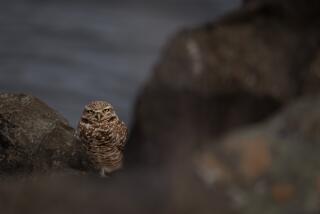Malaysia Barn Owls Turn Rat Predators
- Share via
ULU BERNAM, Malaysia — In the silence of a humid Malaysian night, a blur of white moves through the trees at blinding speed.
The sound of flapping wings and high-pitched squeals punctuate the silence for a few brief seconds before the ghostly shape streaks skyward with its prey and disappears.
Palm oil plantations have introduced the predatory barn owl as a natural solution to rats that feed on the oil palm fruits, which are mashed to extract palm oil.
Malaysia is the world’s top producer and exporter of the lucrative oil, which is used for cooking and in the manufacture of soaps and candles.
Early attempts in Malaysia to use natural predators to protect the palm oil fruit met with little success. Planters initially experimented with snakes but they showed a preference for eating one another.
Then domestic cats were introduced. But they ate the lethal bait meant for the rats, which continued to thrive--until planters stumbled on the idea of using owls.
“Instead of depending on pesticides, we keep owls to check the rat population,” said Mustafa Mohamad, manager of Sungai Erong Estate in Ulu Bernam in the northern state of Perak.
“It is environmentally friendly and it keeps a natural balance in the ecosystem.”
Barn owls were first sighted in Malaysia in 1869 but were considered extremely rare in the country until the 1970s. The first confirmed breeding of the owls in Malaysia was recorded in 1969 on an oil palm estate in the southern state of Johor.
Since then, there has been a very close tie between the owls and the spread of oil palm plantations, with their high rat population.
The nocturnal owls, scientifically known as Tyto alba, have a voracious appetite, each adult consuming up to 2,000 rats a year. Researchers say barn owls in oil palm areas depend almost entirely on live rats for food.
Mustafa said that by keeping owls, his estate can avoid using a chemical-based rat bait which is so toxic that it can kill cattle.
A less potent bait, which kills the rats but not the owls that eat them, is currently being used in Sungai Erong estate, which belongs to United Plantations, a large plantation controlled by Danish interests.
The 7-year-old estate introduced its barn owl colony two years ago. Mustafa said he has so far put up 85 nest boxes in the 9,142-acre estate to increase the owl population. About half the boxes are occupied.
“The progress so far has been satisfactory. The single largest number of young birds ever reared in an oil palm estate in the country so far is nine. But here, we have seen as many as 11 eggs in a nest.”
“We hope to reduce the rat population although we can’t totally eliminate them,” Mustafa said. “If there are no rats, there will be no owls as there will be no more food.”
Whitish in color with a gray and buff tinge and markings, the owl has a flat, heart-shaped face which sharpens hearing. Large round eyes help provide nocturnal vision, boosted by the ability to turn its head 180 degrees.
Mustafa said the use of owls to control rats has yet to catch on in other estates owned by the same company, which has oil palm, coconut and cocoa land totaling 66,700 acres in Perak and neighboring Selangor state.
“Other estate managers are watching how successful the program is,” he said.
More to Read
Sign up for Essential California
The most important California stories and recommendations in your inbox every morning.
You may occasionally receive promotional content from the Los Angeles Times.












